The Art of Darkness

Now THAT’s what I call a caramel sauce. Deep dark and lip-smackingly bitter-sweet. Perfect for a home-made caramel ice cream or a batch of caramel-pumpkin bars. Of course not everybody likes their caramel this dark and smoky. To me, though, those people are nuts.
Of course nobody’s saying you have to cook yours this long. You can take the caramel off the heat any time you like before then, as we’ll see. Start by adding one cup of sugar to a sauce pan or skillet (a skillet will give you a little more control over your heat if you’re simply making caramel…stick to a saucepan if you’re making caramel sauce since there’ll be some splattering).

Add a couple of tablespoons of water, it doesn’t matter how much, just enough to moisten the sugar. It’s all going to cook out anyway.

Give it a stir and turn the heat up to high. Why high? Because not only is it the fastest way to get where you’re going, the intensity of the heat will allow you to leapfrog over some of the more, shall we say, “crystalline” phases of the sugar cooking process, giving you a smoother caramel. Don’t worry, just be careful.
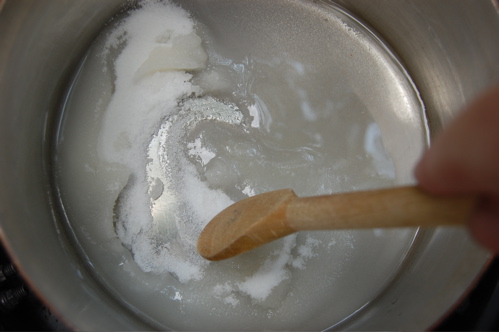
Now then, begin to swirl the pan over the burner, keeping the syrup on the move. After about a minute it’ll start to bubble.
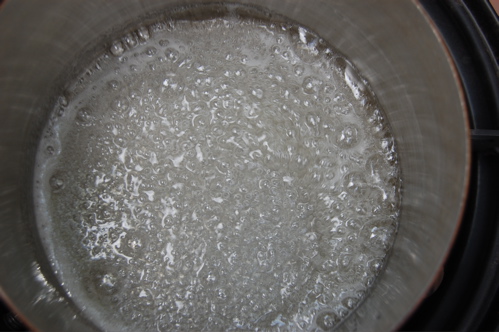
After about three minutes the first spot of color will appear.

Another twenty or thirty seconds and the mixture will turn light amber.

Another ten seconds or so and it’ll be dark amber.

Stop here if you’re making caramel for sticky buns, an upside down cake or tarte tatin, since the caramel will cook a little more as it bakes. Just remove the pan from the heat and add two tablespoons of butter (be careful, it’ll foam up some). Stir the mixture until smooth, and pour into the appropriate baking form while it’s still hot. Making caramel sauce? Then have an open, one-cup carton of heavy cream at the ready and proceed.
Ten more seconds and you’ll start seeing wisps of smoke (not steam) come up. This is the indicator that you’re right around the 350 mark. Press on another five seconds to about this stage of darkness for a spectacular sauce.

What, don’t feel like getting off the burnt sugar party train? Then you’re my kind of people! Let’s rock!
Press on another 5-7 seconds. You’ll get a little more smoke and a brown-black spot will appear in the center of the pan. Bingo: it’s time.
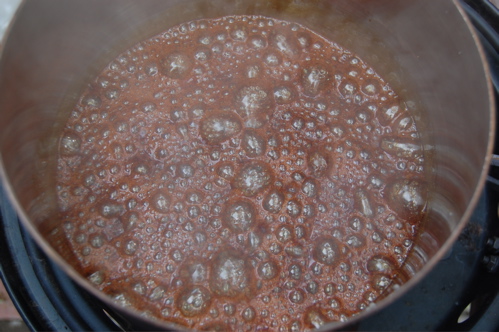
Kill the heat and quickly begin pouring in one cup of warm (or hot) cream, stirring or whisking all the while. See how the caramel is darker still after only about three seconds? Sugar cooks incredibly fast at this stage, the cooler cream will stop that.
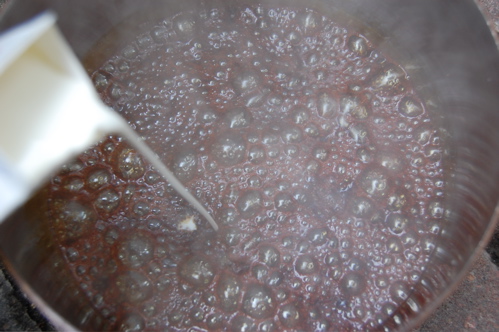
Be aware, it’ll foam up some…
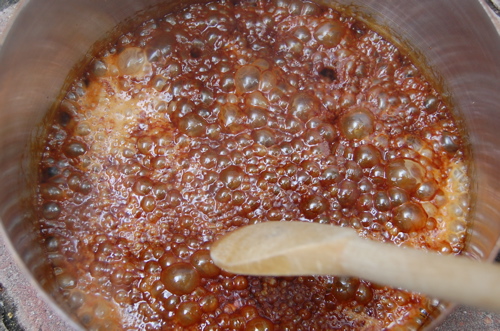
…however in a few moments it’ll calm down into a smooth sauce. Add a little vanilla extract if that’s your thing. If you’re not planning to use it right away, say you want to store it in the fridge for whenever, whisk in another 1/4 cup of cream and pour it into a squeeze bottle (you’ll need to warm the bottle a bit in the microwave or in a water bath before using it).
Oh yeah…that’s the stuff. I’m pouring this over vanilla ice cream tonight, late, while nobody’s looking.
UPDATE: Reader Jennifer adds:
Seems like we have the same taste when it comes to caramel sauce. I know the sugar is dark enough when my eyes sting. Try stopping the cooking w/balsamic sometime–fantastic! Just don’t breathe in until some of the steam clears away! Add some stock and salt, and you have a perfect sauce for venison. Or duck. Or whatever:)
Thanks Jennifer! Can’t wait to try that…
Some mighty fine punning there in the title, Prof. Pastry. And the caramel isn’t bad either!
Dear Joe,
Thank you for your fantastic website and remarkable generosity.
I’ve been trying to make this sauce for a couple of times now, and for fear of burning it opt out at the ten second mark. The color seems right, or so I think, and after stirring in the cream it resembles that of the top photo, slightly lighter. But it tastes (not overly, but unpleasantly) bitter. Taking it off the heat sooner , and it lacks in flavor.
I love caramel, but just can’t get it right. What to do???
I hope you may be able to offer some advice.
Thank you!
Hey Mic!
Sorry to hear that you’re having trouble getting the flavor you want. My thought is that perhaps by introducing a few other flavors, you might get something you like. What about, after cooking the caramel to the point you prefer, you let it cool and then stir in a little vanilla? That might be the magic bullet, as it were.
– Joe
Thank you, Joe!
I really appreciate your kind response.
I’ll follow your advice and give it a go next time.
Thanks again, and have a nice weekend!
You too!
Hi,
I have tried making caramel sauce twice now but both times it has come out grainy. Since heavy cream is so expensive here I decided to try using evaporated milk instead. My proportions were 1 cup white sugar, a few tbsp water, 1/2 cup evap milk (cold from the fridge) and 1 ounce butter (cold from the fridge).
I think I have the caramelisation part figured out. The first time I was a little tender hearted and stopped early. The second I let it go til my eyes stung. Much better flavour the second time.
Once I add the milk however everything goes wrong. I stirred, being careful not to scrape the sides, realised I had lumps and returned to the stove heating it gently. After about 5 minutes of that I said to heck with it and stirred in my butter anyways.
I let it cool a bit and passed the entire lot through a strainer. That improved the texture a bit but I don’t think what I have is how it’s meant to be.
Any advice on what I did wrong? I need to get the hang of this before I expand my waistline eating ruined batches.
Thanks!
Hey Jackie!
Thanks for the email. You’re not doing anything wrong. What you’re experiencing is a temperature issue. The cold cream is simply hardening the caramel when it’s introduced. It’s a very common problem, and one the can be dealt with by simply applying steady, medium heat and a good deal of stirring. The hardened caramel will eventually melt, and provided you don’t heat it too aggressively, the caramel won’t cook any more.
Room-temperature cream will reduce the problem, but most caramels will need to be stirred at least to some extent to melt any crystals or blobs that might form.
Carry on, Jackie!
– Joe
Hi I am having problem just cooking the sugar into caramel. I put a cup of granulated into the pot and two tablespoons of water. I turn the heat on high and start stirring everything together. All is well until it starts boiling and just keeps boiling for two, three minutes until all the water has evaporated and all I am left with is just plain sugar. At this point I add another two tablespoons of water and repeat the process until the mixture boils and all the water evaporates again.
Hey Rachel!
So let me make sure I understand: the mixture is returning to crystalline sugar? If that’s the case my suggestion is to try adding more water — 1/4 cup or so to make sure you’re getting a syrup to begin with. That should fix the problem!
– Joe
Hey Joe! I made the sauce this weekend and it went pretty well. The flavour was absolutely incredible! However I expected the consistency to be thicker than it was and I’m wondering if that was my mistake or if that’s the way it was supposed to be. My caramel sauce (after adding the 1 cup cream, then the 1/4 additional cream since I was storing it for later) was about the thickness/consistency of heavy cream once it cooled down completely. Is it supposed to be this liquidly? It definitely still works for me the way it is, but I’m wondering if adding less cream would have just made it thicker, or if there was something else wrong entirely.
Hey Julie!
Sorry if it’s too runny for you as it is now. Everyone has their own favorite consistency for caramel sauce. I’d say just use the 1 cup of cream next time and it should be noticeably thicker. If you want you can add even less and see she what you think. The nice thing is that you can always reheat the caramel if it’s too thick and add a little more cream or butter if you want. Once it’s added you can’t take it away, unfortunately. Thanks for the question!
– Joe
Thanks Joe, I will do that next time!
Hi Joe
Great stuff, need your help I am making a Caramel Glaze and I am using Caramel paste, and the recipe is also asking for Nappage neutre(nappage glaze) what can I use as a substitute for nappage neutre.
Hi June!
Clear glaze isn’t terribly hard to make, but if you don’t want to take that step an easy substitute is apricot glaze (apricot jam that’s been heated and all the fruit chunks strained out). It not as clear as clear glaze obviously, but it would be a complimentary flavor to caramel and wouldn’t take you much time. That’s all I can think of at the moment!
– Joe
Hi Joe!
LOVE LOVE LOVE your recipes. I’m having trouble with this one though – I tried twice and both times the sugar/water mixture crystallizes. I tried adding more water the second time around, but again after several minutes (does not turn amber), it crystallized. It’s not turning amber at all. I tried stirring less, not stirring at all, using a pastry brush to brush down the sides, etc. Any suggestions?
Hi Grace!
Thanks for the very nice compliment. Sugar crystals are a stage on the way to caramel. Eventually they melt and the mixture turns color. However you can leapfrog over this phase by using higher heat. It’s a bit more intimidating to do it that way and you have to be careful, but it’s much, much faster for a variety of reasons. Best of luck with the final product!
– Joe
I’m definitely going to swirl this into the crème brûlée frozen custard I’m making tonight! It seems like a better way to impart the burnt sugar flavor into the whole batch of ice cream (instead of just a thin layer of torched sugar on the top). Mon bide vous dit, «merci»!
I like the way you think, Helena!
Many thanks for the visit and the comment!
– Joe
Hi Joe,
I will try your recipe tonight. I will use less cream since I want to put this sauce on my chocolate cake. However, I was wondering if it would be a good idea to sprinkle a bit of Fleur de sel on the top of the caramel (once it has been put on the cake :)) ?
What do you think ?
Love your recipes !!
I will never discourage anyone who wants to combine good salt with caramel! It’s excellent…and will make a cool cake topper!
– Joe
Tried and true technique, love, love, love! I shared this recipe at work, with the pastry department, and they could not fathom how this technique works. Because it’s NOT what they learned in culinary school, so therefore “it’s wrong”. Their loss. I will be pouring this caramel over butterscotch pudding tonight. I adapted the recipe from your pastry cream.
Hi, greetings from Indonesia 🙂 how much sugar did you use? it confuse me sometimes about the quantity of the sugar. sometimes it went too dark then sometimes it went burnt 🙁
thank you for your answer 🙂
Hello Echa!
Just a cup, though it’s not the amount sugar that matters so much, but the degree of heat. As you cook your syrup all the water boils away, leaving nothing but cooking sugar. In the final stages of the process it cooks very, very quickly. This is probably why yours became very dark very quickly. My suggestion is to either add the cool cream earlier, or, if you’re not using cream, take the pan off the heat before it gets very dark. It will continue to cook for a minute or so off the heat.
Let me know how it goes — and I hope the weather is good in Indonesia! 😉
– Joe
How does the method, ingredients, and science of caramel sauce, and caramel differ from the chewable caramel candy? In other words, ‘how the heck do you make the chewable stuff?’
Thank you, Mr. Pastry
Hello Omar!
The texture of caramel is mostly dependent on how the proportion of flowing material in the mixture. Of course by itself caramelized sugar is hard candy, but with the addition of things like butter, cream and corn syrup the texture becomes pliable, then chewy, then sauce-like. Does that answer your question?
– Joe
One other important thing I forgot to mention: cooking temperature. The sugar syrup for chewy caramel is generally cooked to the firm ball stage, whereas caramel for caramel sauce is cooked well beyond that. Sorry for the omission!
– Joe